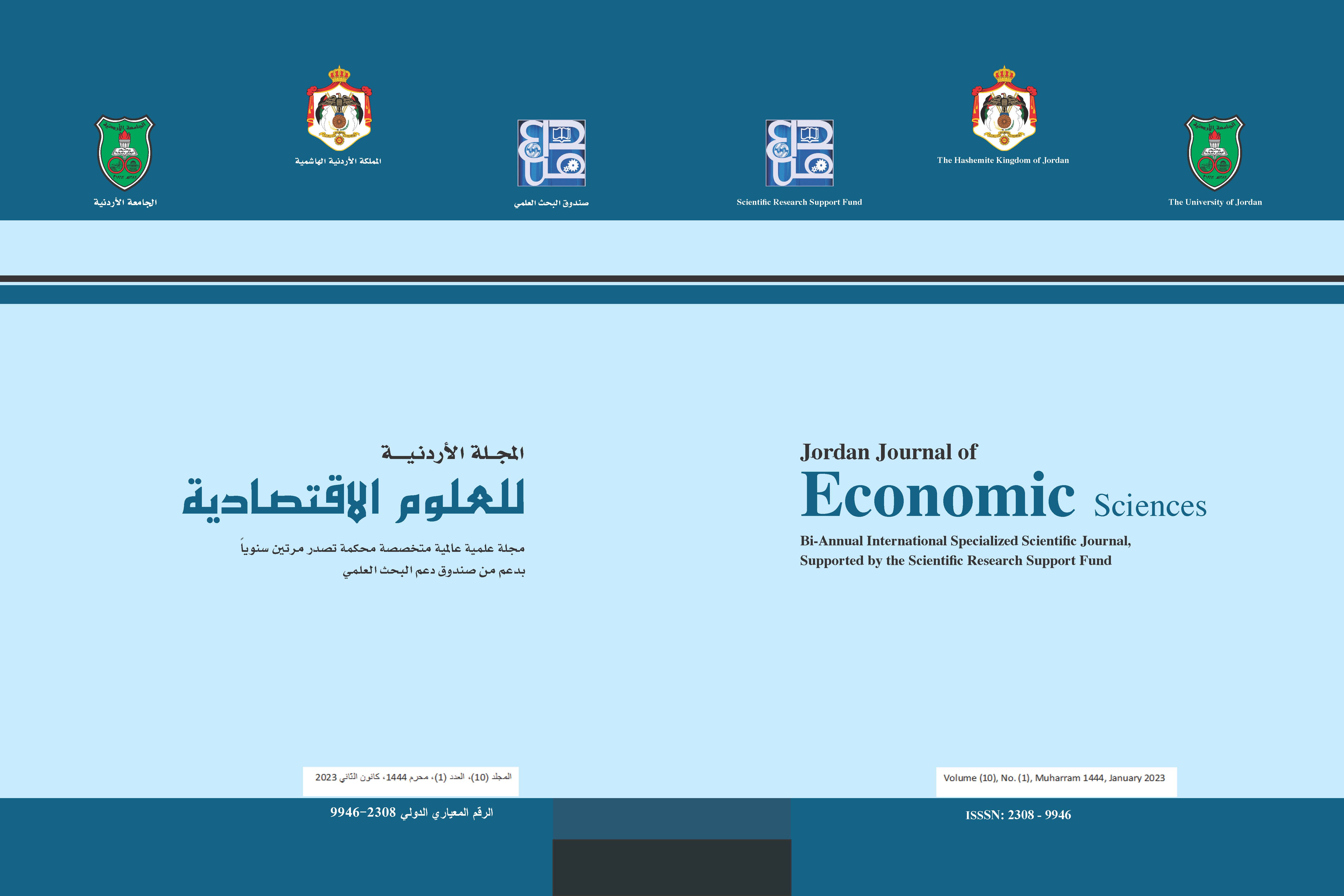Determinants of Jordanian Current Account during the Period (1995-2018)
DOI:
https://doi.org/10.35516/jjes.v10i1.847Keywords:
Budget Deficit, Private Saving Commercial Exposure, Real Exchange Rate, Investment, Terms of Trade, GDP Growth Rate, Current Account BalanceAbstract
Objectives: The study aims to analyze the Jordanian current account determinants during the period of 1995-2018 and demonstrate their importance in affecting the Jordanian current account balance to draw policies and find ways to help reduce the deficit in the current account balance in Jordan.
Methods: The analytical-qualitative and the econometric methods were adopted in addition to the Autoregressive Distributed Lag (ARDL) approach to examine the relationship between the current account deficit and the economic factors affecting it.
Results: The study revealed that there are long-term effects between the study variables, mainly general budget deficit, private savings, trade exposure rate, effective real exchange rate, international exchange rate, gross investment, GDP growth rate, and current account balance. The results also indicated a negative impact of the general budget deficit, private savings, and trade exposure rate on the current account balance and a positive impact of the effective real exchange rate, gross investment, and GDP growth rate on the current account balance. The study shows that Jordan has a deficit in the current account balance, and this is mainly due to the impact of the negative budget deficit and the deficit of its trade balance.
Conclusions: The study recommends implementing some strategies to stabilize the current account deficit, the most important of which are supporting and promoting Jordanian exports, focusing on controlling public expenditure, reducing external debt, and stimulating and diversifying productive sectors.
References
Abdullah, Abdel Mohsen (2017a). Analyzing the Sustainability of the Egyptian Current Account Deficit between Reality and Hope Using Co-Integration (1981-2014), Journal of Commercial Research, Faculty of Commerce, Zagazig University, 39 (1): 123-155.
Abdullah, Abdel Mohsen (2017b). The Economic Factors Determining the Account Deficit of the Egyptian Balance of Payments (1981-2010), Journal of Commercial Research, Faculty of Commerce, Zagazig University, 39(1): 361-391.
Al-Amous, Abdel-Fattah (1997). Authorial Models of the International Monetary Fund and the World Bank: Theoretical Foundations and Applied Cases, a reference to the Tunisian Experience, Journal of Arab Economic Research, Arab Association for Economic Research, 9: 5-52.
Al-Mahdi, Adel (2000), Determinants of the Current Account in The Balance of Payments of Some Arab Countries Using the Error Correction Model. Egypt, Scientific Journal of Economics and Trade, 3: 235-275.
Al-Sawaei, Khaled, Al-Azzam, Anwar (2015), Twin Deficit in Light of Monetary and Financial Variables, Economic Growth and Trade Openness, The Case of Jordan, The Jordanian Journal of Economic Sciences, University of Jordan, 2(2): 97-114.
Ousseini, A. M., Hu, X., & Aboubacar, B. (2017). WAEMU trade and current account balance deficit analysis: A panel VAR approach. Theoretical Economics Letters, 7(4), 834-861.
Anupreet; Kaur Mavi, Nishi, Sharma (2014). Macro-Economic Determinants of Balance of Payment in India, International Journal of Science and Research (IJSR). 3(10): 1703-1708.
Aristovnik, Aleksander (2007). Short- and Medium-Term Determinants of Current Account Balances in Middle East and North Africa Countries, The William Davidson Institute at The University of Michigan.
Aristovnik, Aleksander (2006). The Determinants & Excessiveness of Current Account Deficits in Eastern Europe & the Former Soviet Union, The William Davidson Institute at The University of Michigan.
Calderon CA, Chong A and Loayza N (2002). Determinants of Current Account Deficits in Developing Countries, Contributions to Macroeconomics, 2(1), Article 2.
Chinn, MD and Eswwar, Prasad (2003). Medium-term Determinants of Current Accounts in Industrial and developing Countries: An Empirical Exploration, Journal of International Economics, 59: 47-76.
Clower, Erica and Ito, Hiro (2011). The Persistence and Determinants of Current Account Balances: The Implications for Global Rebalancing, University of California Santa Cruz, Santa Cruz Institute for International Economics (SCIIE).
Daoud, Hussam, (2010). Principles of Macroeconomics: With Application to the Jordanian Economy, Dar Al Masirah, First edition.
Daoud, Hussam; Oran, Ahmad; and Awad, Taleb (2014), Effect of the Foreign Direct Investment on the Jordanian Manufacturing Exports and Imports Performance: An Analytical Study for the Period (1995-2012), the Jordanian Journal of Economic Sciences, University of Jordan, 1(2): 126-139.
Davidson, R., MacKinnon, J. G. (2004). Econometric Theory and Methods. New York Oxford University Press.
Elliott, G., T. J. Rothenberg, and J. H. Stock (1996). Efficient Tests for an Autoregressive Unit Root. Econometrica, 64: 813–836.
Ghassan, Hassan B. and Al-Jefri, Essam H. (2018). The Current Account of Saudi Economy through Intertemporal Model: Evidence from SVAR. Arab Economic and Business Journal, 13(1): 39-59.
Hemeya, El Tahera (2008), The Determinants of the Current Account Deficit in Egypt, Journal of Commerce and Finance, Faculty of Commerce, Tanta University, 1: 511-541.
Herrmann, Sabine and Jochem, Axel (2005). Determinants of Current Account Developments in the Central and East European EU Member States – Consequences for the Enlargement of the Euro Area, Deutsche Bundesbank. Discussion Paper Series 1: Economic Studies No 32.
İsmail, Çeviş and Burak, Çamurdan (2015). The Determinants of the Current Account Balance in Inflation Targeting Countries. İktisat İşletme ve Finans. Pamukkale University, Department of Economics.
Kwalingana, Samson and Nkuna, Onelie (2009). The Determinants of Current Account Imbalances in Malawi, Munich Personal RePEc Archive, April.
Latrash, Taher (1990). Monetary and Banking Economics, University Publications Office, Algeria.
Metwally, M., Tamaschke, R. (1997). Determinants of growth of advertising expenditure on consumer goods and services, Journal of International Marketing and Marketing Research, 22 (3): 147-156.
Mussa, Michael (1976). The Exchange Rate, the Balance of Payments and Monetary and Fiscal Policy under a Regime of Controlled Floating, Scandinavian Journal of Economics, 78 (2): 229-248.
Saidi, Wassaf (2016). A Study of The Impact of Economic Variables on The Current Account of Saudi Arabia During The Period 1995-2014, Journal of Economics and Human Development, University of Saad Blida, 15: 232-248.
Shafei, Muhammad Zaki (1970). Introduction in International Economic Relations, Dar Al-Nahda Al-Arabiya, Beirut.
Sobeih, Majid (2012). The Development of the Current Account of the Palestinian Balance of Payments and Mechanisms to Limit Its Growth for the Period 1994-2009, Arab Journal of Administration, Arab Organization for Administrative Development, 32(2): 116-91.
The Central Bank of Jordan (2013), the Annual Statistical Database.



